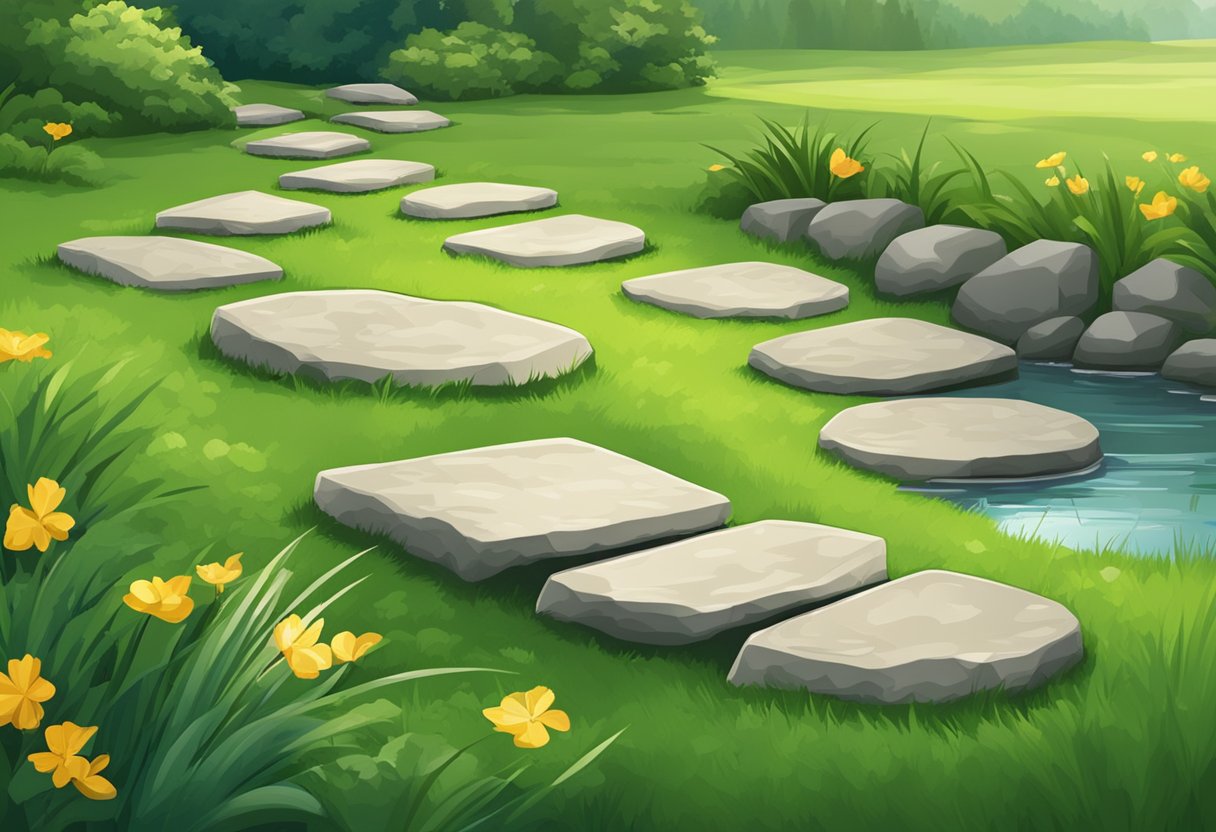Stepping Stones in Grass: A Practical Guide for Your Garden Path
Stepping stones in grass are a popular landscaping feature that can add both functionality and aesthetic appeal to any outdoor space. These stones can be used to create a pathway through a lawn or garden, or as a decorative element in a larger landscape design. Whether you are looking to create a natural-looking path through your backyard or add some visual interest to your front yard, stepping stones in grass can be a great option.

One of the benefits of using stepping stones in grass is that they can help to protect your lawn from heavy foot traffic. By creating a designated path for people to walk on, you can prevent your grass from becoming worn down or damaged. Stepping stones can also be used to create a more formal or structured look in your yard, particularly when they are arranged in a pattern or placed in a specific location.
When it comes to choosing stepping stones for your grass, there are a variety of options available. Stone, concrete, and wood are all popular materials, and each has its own unique look and feel. Some homeowners may prefer the natural look of stone, while others may prefer the durability of concrete or the warmth of wood. Ultimately, the choice will depend on your personal preferences and the overall style of your outdoor space.
Planning and Preparation

When it comes to installing stepping stones in grass, proper planning and preparation are essential to ensure the pathway is functional, aesthetically pleasing, and long-lasting. This section will cover the three key steps in planning and preparing for a stepping stone pathway: choosing the right stepping stones, determining the pathway layout, and calculating spacing and quantity.
Choosing the Right Stepping Stones
The first step in planning a stepping stone pathway is to choose the right stones. There are a variety of materials and styles to choose from, including natural stone, concrete, and brick. It is important to consider the overall look and feel of the pathway, as well as the durability and maintenance requirements of the stones.
Natural stone, such as slate or flagstone, can provide a rustic and natural look to the pathway, but may require more maintenance over time. Concrete stepping stones are durable and low-maintenance, but may not offer the same aesthetic appeal as natural stone. Brick stepping stones can provide a classic and timeless look, but may require more maintenance than concrete.
Determining the Pathway Layout
Once the stepping stones have been chosen, the next step is to determine the pathway layout. This involves deciding on the path’s shape, direction, and any curves or turns. It is important to consider the surrounding landscape, such as trees, garden beds, or other obstacles, when determining the pathway layout.
A straight pathway may be the easiest to install, but a curved pathway can add visual interest and complement the surrounding landscape. It is also important to consider the width of the pathway, as well as any potential drainage issues.
Calculating Spacing and Quantity
The final step in planning and preparing for a stepping stone pathway is to calculate the spacing and quantity of the stones. This involves determining the distance between each stone, as well as the number of stones needed to complete the pathway.
The spacing between each stone should be consistent and allow for comfortable walking. A general rule of thumb is to leave a gap of 18-24 inches between each stone. It is also important to consider the size and shape of the stones when calculating the spacing.
Calculating the quantity of stones needed will depend on the length and width of the pathway, as well as the size of the stones. It is recommended to purchase extra stones to account for any breakage or mistakes during installation.
In summary, proper planning and preparation are key to installing a functional and aesthetically pleasing stepping stone pathway. By choosing the right stones, determining the pathway layout, and calculating spacing and quantity, homeowners can create a beautiful and functional addition to their lawn or garden.
Ground Preparation
Before installing stepping stones in grass, proper ground preparation is essential for ensuring a level and stable surface. The following subsections outline the necessary steps for ground preparation.
Leveling the Ground
The first step in ground preparation is to level the ground where the stepping stones will be placed. This can be done by removing any large rocks or debris and using a garden spade to smooth out the surface. It is important to ensure that the ground is level to prevent any tripping hazards or unevenness in the finished pathway.
Adding a Base Layer
To create a stable foundation for the stepping stones, a base layer of sand or gravel should be added to the leveled ground. This layer should be about 2-3 inches deep and should be spread evenly across the entire area where the stepping stones will be placed. The base layer helps to prevent shifting or sinking of the stepping stones over time.
Excavating for Stepping Stones
After the base layer has been added, it is time to excavate the areas where the stepping stones will be placed. This can be done by using a garden spade to dig holes in the base layer that are slightly larger than the stepping stones. The holes should be dug to a depth that allows the stepping stones to sit flush with the ground surface.
By following these steps for ground preparation, the installation of stepping stones in grass can be a successful and long-lasting addition to any outdoor space.
Laying Stepping Stones
When it comes to laying stepping stones on grass, there are a few important steps to follow to ensure a successful installation. The following subsections will guide you through the process of placing, securing, and filling the gaps between the stepping stones.
Placing the Stepping Stones
The first step is to decide on the placement of the stepping stones. Use pavers or cut pieces of stone to create a pathway that is both functional and aesthetically pleasing. Once the placement has been determined, use a garden trowel to mark the outline of each stone by cutting into the grass.
Securing the Stepping Stones
To ensure that the stepping stones stay in place, it is important to secure them properly. Begin by digging a hole for each stone that is slightly deeper than the thickness of the stone. Place the stone in the hole and use a rubber mallet to tap it firmly into place. Check to make sure that the stone is level with the surrounding grass. Repeat this process for each stone.
Filling the Gaps
After the stepping stones have been secured, it is important to fill the gaps between them. Use a mixture of sand and soil to fill the gaps, making sure to pack it down firmly. This will help to prevent weeds from growing between the stones and will also provide a stable surface for walking.
In conclusion, laying stepping stones on grass can be a simple and rewarding project that can enhance the beauty and functionality of your outdoor space. By following these steps, you can create a durable and attractive pathway that will last for years to come.
Landscaping and Finishing Touches

Planting Around Stepping Stones
When it comes to landscaping around stepping stones, it’s important to consider the amount of foot traffic that will be walking on the stones. Low-maintenance plants such as sedum, thyme, and creeping phlox are great options as they can handle some foot traffic and don’t require much upkeep. It’s also important to choose plants that won’t grow too tall and cover the stepping stones. Grass seed can also be used to create a seamless transition between the stones and the surrounding lawn.
Adding Decorative Elements
Stepping stones can also serve as focal points in a landscape design. Adding decorative elements such as mulch or decorative rocks around the stones can enhance their visual appeal. It’s important to choose materials that complement the overall design of the landscape and won’t detract from the stepping stones.
Regular Cleaning and Maintenance
Regular cleaning and maintenance is key to keeping stepping stones looking their best. This includes removing any debris or dirt that accumulates on the stones and trimming any plants that may be encroaching on the stones. It’s also important to regularly mow the surrounding grass to prevent it from growing too tall and covering the stones.
Overall, with a little bit of planning and regular upkeep, stepping stones can be a beautiful and functional addition to any landscape design.
Additional Considerations

Creating a Stable Base
When installing stepping stones in grass, it is important to create a stable base to prevent the stones from sinking or shifting over time. To do this, start by removing any grass or vegetation from the area where the stones will be placed. Then, use a half-moon edger or shovel to create a perimeter around the area and remove the top layer of soil. This will allow you to create a level surface for the stones to rest on.
Next, fill the area with a layer of crushed stone or gravel, making sure to spread it evenly and compact it with a wheelbarrow or tamper. This will provide a stable base for the stepping stones and help prevent them from sinking into the ground over time.
Preventing Wobbling and Movement
To prevent the stepping stones from wobbling or moving once they are installed, it is important to make sure they are level and secure. Start by placing the stones on top of the base layer and checking for any wobbling or unevenness. If necessary, add or remove some of the base material to ensure the stones are level.
Once the stones are level, fill in any gaps around them with additional base material, making sure to pack it down firmly to prevent movement. You can also use a small amount of concrete to anchor the stones in place, if desired.
Designing for Water Drainage
When installing stepping stones in grass, it is important to consider water drainage to prevent pooling or flooding. To do this, make sure the stones are installed at a slight angle, with the higher end facing away from the walkway or patio. This will allow water to flow away from the area and prevent it from pooling around the stones.
Additionally, consider using natural stone or other permeable materials for the stepping stones, as these will allow water to seep through and be absorbed by the ground below. This can help prevent erosion and other drainage issues in your outdoor space.
Overall, by following these tips and considering factors such as stability, wobbling, and drainage, you can create a beautiful and functional walkway or patio using concrete stepping stones in your grassy outdoor setting.
DIY Project Tips

Tools and Materials Checklist
Before starting the installation of stepping stones in grass, it is important to gather all the necessary tools and materials. Here is a checklist of items required for this DIY project:
- Garden trowel
- Rubber mallet
- Sod cutter
- Stepping stones
- Sand or gravel
- Decorative elements (optional)
Step-by-Step Installation Guide
- Determine the location of the stepping-stone path and mark it with spray paint or stakes and string.
- Use a sod cutter to remove the grass in the marked area, making sure to remove any roots or debris.
- Level the ground with a garden trowel and add a layer of sand or gravel to create a stable base for the stepping stones.
- Place the stepping stones on the sand or gravel, making sure they are level and evenly spaced.
- Use a rubber mallet to tap each stepping stone into place.
- Add decorative elements, such as mulch or rocks, around the stepping stones to enhance the look of the path.
Troubleshooting Common Issues
- Uneven ground: If the ground is uneven, use additional sand or gravel to level it out before placing the stepping stones.
- Stepping stones not level: If a stepping stone is not level, remove it and add or remove sand or gravel as needed to level the base.
- Cutting grass around the stepping stones: Use a string trimmer to cut the grass around the stepping stones, being careful not to damage them.
By following these simple steps and using the proper tools and materials, anyone can create a beautiful and functional stepping-stone path for their guests to enjoy.
Frequently Asked Questions

What is the best method to install stepping stones in a lawn?
The best method to install stepping stones in a lawn is to first lay them out in the desired pattern. Then, use a shovel to remove the grass and soil from the area where each stone will be placed. Make sure the ground is level and compacted before placing the stones. It is recommended to use a layer of sand or gravel under the stones to improve stability and prevent shifting.
Can stepping stones be laid directly on grass or should an underlayment be used?
Stepping stones can be laid directly on grass, but it is recommended to use an underlayment for added stability. A layer of sand or gravel under the stones can help prevent shifting and sinking over time. Additionally, using an underlayment can help prevent weeds from growing between the stones.
What are some creative design ideas for incorporating stepping stones into a grassy landscape?
There are many creative design ideas for incorporating stepping stones into a grassy landscape. Some ideas include creating a winding path through the lawn, using different shapes and sizes of stones to create a unique pattern, or incorporating stones into a water feature or garden area. Additionally, using stones of different colors or textures can add visual interest to the landscape.
How do you prepare the ground before placing stepping stones?
Before placing stepping stones, it is important to prepare the ground by removing any grass or weeds from the area. Use a shovel to dig out the soil to the depth of the stones plus an additional inch or two for the underlayment. Make sure the ground is level and compacted before placing the stones.
What materials are recommended for use under stepping stones to ensure stability?
To ensure stability, it is recommended to use a layer of sand or gravel under stepping stones. This will help prevent shifting and sinking over time. Additionally, using a landscape fabric underlayment can help prevent weeds from growing between the stones.
Are there any advantages to using rubber stepping stones over traditional stone pavers?
Rubber stepping stones offer several advantages over traditional stone pavers. They are lightweight and easy to install, making them a great option for DIY projects. Additionally, rubber stepping stones are slip-resistant and provide a cushioned surface that is gentle on feet and joints. They are also durable and long-lasting, making them a cost-effective option for those looking to add stepping stones to their landscape.


